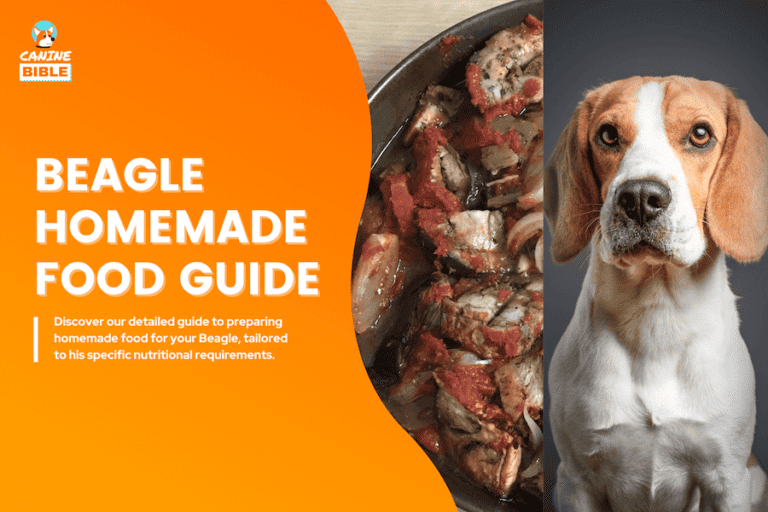Can Dogs Eat Beef Jerky? Is It Bad or Good?

Canine Bible is reader-supported. We receive affiliate commissions via some of our links. This doesn’t affect rankings. Learn more.
Can dogs eat beef jerky? It depends. Not all beef jerky treats are created equal. There are many different types of beef jerky treats for dogs, so you need to be mindful of which one you feed to dogs. Generally, dogs can safely enjoy beef jerky treats from a single ingredient containing appropriate sodium levels and no spices or preservatives. However, several important risks and common beef jerky ingredients could harm your dog’s health. This article clearly shows what ingredients to look for and which to avoid. We also analyze the different types of beef jerky for dogs to help you pick the healthiest and safest of them. Let’s dive right in!
What Is Beef Jerky for Dogs?
Beef jerky for dogs is similar to human beef jerky but explicitly formulated for canine companions. It contains pure, high-quality protein without high sodium concentrations or potentially toxic ingredients like onions. Beef jerky is produced through dehydration, which removes moisture from the meat and has a concentrated form. This process compresses one pound of beef into just four ounces of jerky.[1] As the moisture content is removed, beef jerky can be kept without refrigeration and stored for long periods without spoiling, making it an easy shelf storage option compared to many other canine treats.
Types of Beef Jerky
Is Beef Jerky Good For Dogs?
Generally, beef jerky, made specifically for dogs, is a healthy and nutritious snack that is extremely high in protein (34-74%) and low in carbs. It also contains many vitamins and minerals, including zinc, iron, vitamin B12, phosphorus, and folate. Plus, it has a long shelf life and is portable, making it a great on-the-go option.
Beef jerky also has a healthier nutritional ingredient composition than many traditional dog treats. Due to the low heat applied during the dehydrating process, beef is never exposed to as high a temperature as other treats, meaning it retains more nutrients and suffers less nutrient loss. The taste and flavor of the beef are also preserved, making it palatable. Some beef jerky dog manufacturers even use USDA-approved free-range beef, so you don’t have to worry about the quality.
Other Reasons Beef Jerky Is Good For Dogs
Can Dogs Eat Beef Jerky Made for Humans?
While homemade jerky and dog-specific jerky treats can all be good options for your dog, feeding your dog human-intended jerky treats is not recommended.
Beef jerky for human consumption could have ingredients unsuitable for dogs. Here are some of those potentially harmful ingredients:
Health Benefits of Beef Jerky For Dogs
Here is a breakdown of the ingredient composition of beef to help you understand whether this food is nutritious. We also explain each component to help you determine if it’s safe and healthy.
The following information is for 1oz (28.35 g) of beef jerky.
Here are a few more reasons why beef jerky is beneficial for dogs:
May Help Build & Maintain Muscle Mass
Beef jerky packs an abundance of protein, up to 74% of high-quality proteins. Protein supplies essential amino acids needed to develop and maintain muscle growth, mass, and tissue repair.[7]
May Boost Immunity
Selenium is a vital trace element with abundant benefits, from antiviral properties to preventing autoimmune diseases. Not only does selenium improve cognitive and immune function, but it could also reduce your risk for certain chronic illnesses.[9]
May Help Blood & Nerve Cells Health
Beef jerky is an invaluable dietary source of vitamin B12, which is necessary for the healthy formation of blood cells and brain and nervous system development. It also aids with skin improvements and promotes a positive mood, better sleep quality, and neural regeneration.[8]
May Help Improved Oxygen Levels
Its iron content is essential for overall vitality. It aids red blood cells (RBCs) in transporting oxygen to the different cells around the body, and it’s necessary for energy levels, brain function, and healthy growth and development.
Can Dogs Eat Beef Jerky?
After a rigorous nutrient analysis, we advise only feeding beef jerky explicitly made for canine consumption. Full Moon Beef Jerky Tenders and Blue Buffalo Nudges Jerky Cuts are some of our favorite beef jerky treats for dogs. Beef jerky is a protein-packed and delicious snack that is low-fat and calorie-dense, making it ideal for dogs who want to maintain a healthy weight and muscle growth and recovery. These treats are a source of essential minerals, including iron, magnesium, and zinc. Iron is necessary for healthy red blood cells, magnesium plays a role in enzyme function and nerve-muscle signaling, and zinc contributes to growth, immune system health, and wound healing.
Though beef jerky is a healthy snack, dogs should consume it in moderation. Treats should make up no more than 10% of your pet’s daily calorie requirement. It’s also good practice always to check the label to ensure your dog’s safety
Is Beef Jerky Bad For Dogs?
Dog-friendly beef jerky treats or homemade are not bad for dogs as long as the ingredients meet the safety standards for dog consumption. Of course, anything in excess is bad.
On the other hand, beef jerky brands for human consumption are bad for dogs because they typically consist of harmful ingredients such as excessive salt, garlic, onion, peppers, spicy flavors, xylitol, and other preservatives and additives. Be cautious of dog beef jerky brands. Since 2007, the FDA has received reports of illnesses in pets associated with consuming jerky pet treats. These illnesses include gastrointestinal upset, kidney failure, liver diseases and death in dogs.[10]
However, the FDA has warned that certain beef jerky brands can be hazardous to our canine companions. So, it’s essential to thoroughly research the brand and select those derived from trusted sources, as some brands, specifically from China, have been linked with cases of poisoning and death in dogs.[11]
It is essential to consider not only the brand you’re purchasing but also its ingredients. Double-check that all the ingredients used are safe for them. Many store-bought products contain spices like cayenne pepper and paprika along with onion powder or garlic, which aren’t suitable for canine consumption – their stomachs can’t handle spicy foods as well as humans. Similarly, protein-rich foods like beef jerky dog treats should be avoided in dogs with liver or kidney disease, and if your dog has any underlying health issue, always speak to your vet before changing their diet. Dogs allergic to beef should avoid these treats.
Possible Risks of Beef Jerky in Dogs
Let’s examine the potential adverse effects and dangers that beef jerky made for humans may pose to dogs.
Possible Side Effects of Beef Jerky In Dogs
The following symptoms may indicate a bad reaction to beef jerky.
What Should I Do If My Dog Ate Beef Jerky Made For Humans?
One or two beef jerky bites shouldn’t be too much of a cause for concern. Just prevent your dog from eating it regularly. However, if your dog overate beef jerky or is showing symptoms of an adverse reaction, provide plenty of cool and fresh water to your pup to stay hydrated and counteract salt overload in the beef jerky. Be vigilant for signs of sodium poisoning.
However, if you suspect that the beef jerky contains spices, garlic, onion, or xylitol—or if the symptoms of hypernatremia have prevailed for more than 24 hours—do not wait; contact your vet immediately.
Can’t reach your vet? Contact the Pet Poison Helpline at 1-855-764-7661 or chat live with a veterinary professional via our online vet chat or video chat support (24 hours a day, 7 days a week).
Dogs showing worsening symptoms, such as blood in their vomit or stool, difficulty breathing, weakness, or collapse, should be taken to the veterinarian immediately.
Can Beef Jerky Kill Dogs?
The FDA linked beef jerky made in China to over one thousand canine deaths. Nevertheless, it’s safe to say that dog-friendly and even human-intended beef jerky won’t kill your dog. Inspect the ingredients before feeding them to your dog and avoid beef jerky products made in China.
Are Dogs Allergic To Beef Jerky?
While not common, some dogs may be allergic to beef jerky or any of its components. Symptoms can include itching, swelling, hives, and, in severe cases, anaphylaxis, a medical emergency. If you suspect your dog is allergic to any food, including beef jerky, it is crucial to consult a veterinarian. Your vet can provide appropriate advice and help you formulate a safe diet plan for your dog. We also recommend conducting an at-home dog allergy test to determine if your dog is sensitive or intolerant to certain foods.
How to Safely Feed Beef Jerky to Dogs
When feeding beef jerky to your dog, it’s best to follow a few simple guidelines to help keep them safe:
Here are some creative and safe ways to incorporate beef jerky into your dog’s diet:
As with any new food, it’s recommended to start slowly and feed gradually to give the digestive system time to adjust.
How Much Beef Jerky Can Your Dog Eat?
Feeding beef jerky to dogs depends on their size.
Remember that dogs’ maximum daily sodium intake is 200 mg. To be safe, check the sodium levels of each piece.
| Dog Szie | Peices (Per Day) |
|---|---|
| 5 – 15 lbs | 1/2 – 1 |
| 15 – 30 lbs | 1 – 2 |
| 30 – 50 lbs | 2 – 3 |
| 50 – 75 lbs | 3 – 5 |
Can Puppies Eat Beef Jerky?
Puppies generally have more sensitive digestive systems than adult dogs and may be more prone to an upset stomach after eating rich or high-fat foods. Some puppies may tolerate small pieces of beef jerky, mainly when used as high-reward training treats. It’s worth remembering that puppies need fewer calories than larger dogs and higher protein content to aid growth and development. They must have a well-balanced diet, so treats such as hot dogs should only be fed in small quantities.
Can Pregnant Dogs Eat Beef Jerky?
Yes, pregnant dogs can moderately consume plain beef jerky. Beef jerky is high in protein and fat, which is critical for a healthy pregnancy.
Frequently Asked Questions
Can Dogs Eat Beef Jerky? — Conclusion
Beef jerky can be a tasty treat for dogs if it is plain and contains no extra seasonings, preservatives, or other hazardous ingredients. Remember that too much sodium and fat from beef jerky can lead to health issues like pancreatitis, stomach upsets, or obesity; therefore, it is essential to carefully monitor the amount of beef jerky given to your pup. When in doubt, consult your veterinarian regarding safe treats for your pet. They will help you navigate the best option for your furry friend’s health. It is important to note that beef jerky should not be a substitute for your pup’s regular diet; it should only be used as an occasional treat. Therefore, feed them appropriately and always practice responsible pet ownership!
Like It? Subscribe & Share!
Sources
Canine Bible uses only high-quality sources, including peer-reviewed studies, to support the facts within our articles. Read our editorial process and product review methodology to learn more about how we fact-check, test products, and keep our content accurate, reliable, and trustworthy.
- USDA Jerky & Food Safety
- Sodium CDC
- Nutrient Requirements of Dogs & Cats
- Metabolic Diversity
- Circulating Homocysteine
- Beef Jerky Nutrient Profile
- PubMed:Dietary Protein
- Texas A&M University: Veterinary School
- Selenium & Dogs
- FDA Investigates Jerky Pet Treats
- NBC News
- Hypernatremia In Dogs
- Fanconi Syndrome & Jerky Treats
- Pet Food-Associated Dietary Exogenous Thyrotoxicosis
Canine Bible authorship represents the unified voice of our entire editorial team and our in-house veterinarians rather than a single author. Each article, blog post, and review published under the Canine Bible name undergoes a rigorous review process, involving all team members to guarantee accuracy and up-to-date in accordance with the latest veterinarian research. This collaborative effort is an integral part of our editorial process and aligns with our four pillars of content creation. This approach ensures our content is backed by expert knowledge and factual information, offering our readers reliable, actionable, and trustworthy content.







